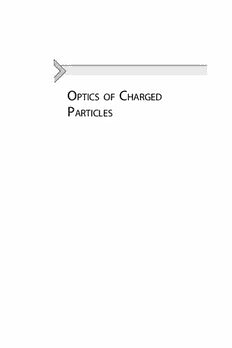
Optics of Charged Particles PDF
Preview Optics of Charged Particles
O C PTICS OF HARGED P ARTICLES O C PTICS OF HARGED P ARTICLES Second Edition HERMANN WOLLNIK New Mexico State University, Las Cruces, NM, United States AcademicPressisanimprintofElsevier 125LondonWall,LondonEC2Y5AS,UnitedKingdom 525BStreet,Suite1650,SanDiego,CA92101,UnitedStates 50HampshireStreet,5thFloor,Cambridge,MA02139,UnitedStates TheBoulevard,LangfordLane,Kidlington,OxfordOX51GB,UnitedKingdom Copyright©2022ElsevierInc.Allrightsreserved. Nopartofthispublicationmaybereproducedortransmittedinanyformorbyanymeans, electronicormechanical,includingphotocopying,recording,oranyinformationstorageand retrievalsystem,withoutpermissioninwritingfromthepublisher.Detailsonhowtoseek permission,furtherinformationaboutthePublisher’spermissionspoliciesandour arrangementswithorganizationssuchastheCopyrightClearanceCenterandtheCopyright LicensingAgency,canbefoundatourwebsite:www.elsevier.com/permissions. Thisbookandtheindividualcontributionscontainedinitareprotectedundercopyrightby thePublisher(otherthanasmaybenotedherein). Notices Knowledgeandbestpracticeinthisfieldareconstantlychanging.Asnewresearchand experiencebroadenourunderstanding,changesinresearchmethods,professionalpractices, ormedicaltreatmentmaybecomenecessary. Practitionersandresearchersmustalwaysrelyontheirownexperienceandknowledgein evaluatingandusinganyinformation,methods,compounds,orexperimentsdescribed herein.Inusingsuchinformationormethodstheyshouldbemindfuloftheirownsafety andthesafetyofothers,includingpartiesforwhomtheyhaveaprofessionalresponsibility. Tothefullestextentofthelaw,neitherthePublishernortheauthors,contributors,or editors,assumeanyliabilityforanyinjuryand/ordamagetopersonsorpropertyasamatter ofproductsliability,negligenceorotherwise,orfromanyuseoroperationofanymethods, products,instructions,orideascontainedinthematerialherein. BritishLibraryCataloguing-in-PublicationData AcataloguerecordforthisbookisavailablefromtheBritishLibrary LibraryofCongressCataloging-in-PublicationData AcatalogrecordforthisbookisavailablefromtheLibraryofCongress ISBN:978-0-12-818652-7 ForInformationonallAcademicPresspublications visitourwebsiteathttps://www.elsevier.com/books-and-journals Publisher:SusanDennis AcquisitionsEditor:CharlotteCockle EditorialProjectManager:SusanIkeda ProductionProjectManager:BharatwajVaratharajan CoverDesigner:VictoriaPearson TypesetbyMPSLimited,Chennai,India Contents Forewordtosecondedition xi Foreword xiii 1. Gaussian optics and transfer matrices 1 1.1 Themethodoftransfermatrices 1 1.1.1 Thedescriptionofstraightraysinopticalsystems 1 1.1.2 Propertiesofthinlenses 3 1.2 Anopticalsystemthatcontainsonethinlens 4 1.2.1 Theformationofarealimageorofavirtualimage 6 1.3 Generalopticalsystems 8 1.3.1 Thesignificanceofthedisappearanceofelementsof transfermatrices 10 1.4 Transfermatricesoflensmultiplets 11 1.4.1 Thetransfermatrixofadoubletoftwothinlenses 12 1.5 Roundlensesforchargedparticles 18 References 19 2. General relations for the motionof charged particles in electromagnetic fields 21 2.1 Energy,velocity,andmassofacceleratedchargedparticles 21 2.2 Forcesonchargedparticlesinelectromagneticfields 22 2.2.1 Themagneticrigidity 25 2.2.2 Theelectrostaticrigidity 26 2.3 Thedescriptionofabundleofparticlesofdifferentkinetic energiesandmasses 28 2.4 Therefractiveindexoftheelectromagneticfield 29 2.5 TheEuler(cid:1)Lagrangeequations 32 Appendix 33 Hamilton’svariationalprincipleandtheLagrangeequations 33 Themotionofchargedparticlesintime-independent magneticandelectrostaticfields 35 References 37 3. Quadrupolelenses 39 3.1 Theelectricandmagneticfieldsinquadrupolelenses 40 3.1.1 Fieldsinelectricquadrupolelenses 41 v vi Contents 3.1.2 Fieldsinmagneticquadrupolelenses 42 3.2 Particletrajectoriesinquadrupolelenses 43 3.2.1 Theequationsofmotion 43 3.2.2 Focusingpropertiesofsinglequadrupolelenses 46 3.3 Thedesignofquadrupolemultiplets 49 3.3.1 Quadrupoledoublets 50 3.3.2 Quadrupolemultiplets 56 3.4 Thin-lensapproximationsforquadrupolemultiplets 59 3.4.1 Doublypoint-to-parallelfocusingthin-lensquadrupole multiplets 60 3.4.2 Stigmaticfocusingthin-lensquadrupolemultiplets 63 3.4.3 ThinlensquadrupolemultipletsforwhichðxjaÞand ðbjbÞvanishsimultaneously 65 3.4.4 A“beamrotator” 65 References 66 4. Sector fields 67 4.1 Homogeneousmagneticsectorfields 68 4.1.1 Particletrajectoriesinhomogeneousmagneticsectorfields 68 4.1.2 Focusinganddispersingpropertiesofhomogeneousmagnetic sectorfields 72 4.1.3 Obliqueentranceandexitofparticlebeamsinsectormagnets 81 4.2 Inhomogeneousmagneticsectorfieldsformedbyinclinedplanarpole faces(wedgemagnets) 86 4.2.1 Particletrajectoriesinwedgemagnets 87 4.2.2 Focusinganddispersingpropertiesofwedgemagnets 90 4.3 Radiallyinhomogeneoussectorfieldsformedbyconicalpolefacesor toroidalelectrodes 92 4.3.1 Theequationsofmotioninradiallyinhomogeneoussectorfields 93 4.3.2 Particletrajectoriesinradiallyinhomogeneousmagneticor electrostaticsectorfields 98 4.3.3 Focusinganddispersingpropertiesofradiallyinhomogeneous sectorfields 100 4.3.4 Examplesofradiallyinhomogeneoussectorfields 104 4.4 Particleflighttimesinradiallyinhomogeneoussectorfields, quadrupoles,andfield-freeregions 106 Appendix 109 Paraxialtrajectoriesinwedgemagnets 109 References 112 Contents vii 5. Chargedparticlebeams inphase space 113 5.1 Liouville’stheoremandfirst-ordertransfermatrices 114 5.2 Phase-spaceareasofparticlebeamspassingthroughopticalsystems 115 5.2.1 Phase-spaceareasofparticlebeamsinfield-freeregions 116 5.2.2 Phase-spaceareasofparticlebeamsinimage-formingsystems 117 5.2.3 Thevirtualthinobjectlens 118 5.3 Beamenvelopes 120 5.3.1 Envelopesofbeamswithparallelogram-likephase-spaceareas 122 5.3.2 Envelopesofbeamswithoctagon-likephase-spaceareas 123 5.3.3 Envelopesofbeamswithellipticalphase-spaceareas 123 5.4 Positionsandsizesofenvelopeminima 129 5.4.1 Imagesandpupils 129 5.4.2 Beamwaists 130 5.4.3 Pupilsandwaistsforpoint-to-parallelfocusingsystems 131 5.5 Minimalbeamenvelopesatpostulatedlocations 131 5.6 Liouville’stheoremanditsapplicationtowide-anglebeams 134 5.6.1 Abbe’s“SineLaw”foratwo-dimensionalphasespace 135 5.6.2 Thecurrentdensity 136 5.7 Beamswithspacecharge 137 5.7.1 Thecompensationofspacechargeinparticlebeams 138 5.7.2 Thecalculationoftransporteffectsinconstantdiameter ionbeams 139 5.7.3 Thedesignofbeamlinesforhigh-intensitybeams 141 References 143 6. Particle beams inperiodic structures 145 6.1 Single-particletrajectoriesandbeamenvelopes 146 6.1.1 Systemswithpostulatedopticalproperties 149 6.1.2 Opticalsystemsthathaveidenticalentranceandexitbeams 151 6.2 Ringsofunitcells 158 6.2.1 Lateralbeamdeviations 158 6.2.2 Longitudinalbeamdeviations 159 References 160 7. Fringe fields 161 7.1 Particletrajectoriesinthefringefieldsofdipolemagnets 161 7.1.1 Positionsofeffectivefieldboundariesindipolemagnets 163 7.1.2 Fringe-fieldshuntsfordipolemagnets 165 viii Contents 7.1.3 Fringe-fieldshuntsforhomogeneousandinhomogeneous dipolemagnets 169 7.1.4 y-Focusinginthefringefieldsofdipolemagnets 169 7.1.5 Transfermatricesofrealisticmagneticsectorfields 174 7.2 Particletrajectoriesinfringefieldsofelectrostaticdeflectors 174 7.2.1 Electrostaticdeflectorsbiasedsymmetricallytoground 175 7.2.2 Electrostaticdeflectorsbiasedasymmetricallytoground 176 7.2.3 Transfermatricesofrealisticelectrostaticsectorfields 178 7.3 Particletrajectoriesinthefringefieldsofquadrupolelenses 179 References 182 8. Image aberrations 183 8.1 Systematicsofimageaberrations 183 8.2 Originofimageaberrations 190 8.2.1 Geometricaberrations 191 8.2.2 Chromaticaberrations 196 8.3 RelationsbetweencoefficientsofEq.(8.2)duetotheconditionof symplecticity 201 8.3.1 Canonicaltransformationswithtimebeingtheindependentvariable 201 8.3.2 Canonicaltransformationswithpositionbeingthe independentvariable 202 8.3.3 Theconditionofsymplecticity 204 8.4 Imageaberrationsofnthorder 211 8.4.1 Overallimageaberrations 213 8.4.2 Theaberrationdrivingtermsofallorders 217 8.4.3 Imageaberrationsduetofringefields 217 Appendix 222 Coefficientsofimageaberrationsofnthorder 222 Equationsofmotionintime-independentfields 223 Explicitparticletrajectoriesinradiallyinhomogeneouselectromagnetic sectorfields 224 References 228 9. Design of particle spectrometers and beamguide lines 229 9.1 Single-sectormagneticspectrometers 229 9.1.1 Ionbeamsfrompoint-likeandslit-likeionsources 232 9.1.2 Asectormagnetionanalyzerassistedbyonequadrupolelens 233 9.1.3 Aphase-spaceadapterforionbeamsinsectormagnets 234 9.2 Aqualityfactorforparticlespectrometers 235 9.2.1 Arigidity-orQΔ-value 236 Contents ix 9.2.2 AnenergyQ -valueandamassQ -value 240 K m 9.2.3 AQ-valueforNcascadedspectrometers 241 9.2.4 Achromaticsystems 242 9.3 Time-of-flightparticlespectrometers 245 9.3.1 AQ-valuefortime-of-flightmassanalyzers 247 t 9.3.2 Isochronousopticalsystems 248 9.3.3 Angleandenergy-focusingisochronousopticalsystems 249 9.4 Thealignmentofanopticalsystemandthecorrectionofits aberrations 251 9.4.1 Thecorrectionofthesecond-orderapertureaberrationsin magneticsystems 253 9.4.2 Thecorrectionofimageaberrationsinelectrostaticsystems 263 References 265 10.Time-of-flight mass spectrographs 267 10.1 Time-of-flightmassspectrographsthatusesectorfields 269 10.1.1 Time-of-flightmassspectrographsthatusemagnetic sectorfields 269 10.1.2 Acceleratorstorageringsusedastime-of-flightmass spectrographs 270 10.1.3 Determiningthepassagetimeforhigh-energyions 271 10.2 Time-of-flightmassspectrographsthatuseelectrostaticsectorfields 272 10.3 Low-energyionbeamsintime-of-flightmassspectrographs 275 10.3.1 Ioncoolinginaquadrupoleiontrap 275 10.3.2 Coolingionsinandextractingthemoutofaflattrap 277 10.3.3 RF-carpetstointroduceionsintocoolers 277 10.4 Acceleratingandbunchingofionsinpulsedelectricfields 278 10.4.1 Acceleratingandbunchingbyasinglepulsedfield 279 10.4.2 Ionbunchingtoadesiredposition 281 10.4.3 Delayedionextraction 283 10.5 Energy-isochronoustime-of-flightmassspectrographsthatuse ionmirrors 285 10.5.1 Energy-isochronoustime-of-flightmassspectrographsthat usegriddedionmirrors 285 10.5.2 Energy-isochronoustime-of-flightmassspectrographsthat usegrid-freeionmirrors 287 10.5.3 Energy-isochronoustime-of-flightmassspectrographsthat useseveralionmirrors 287 10.6 Amultireflectiontime-of-flightmassspectrograph 288 10.6.1 MovingionsintoandextractingthemoutofaMRTOF-MS 290 x Contents 10.6.2 Determiningthenumberoflapsthationshaveperformed inamultireflectiontime-of-flightmassspectrograph 291 10.6.3 ThedesignofaMRTOF-MSforprecisemassdeterminations 292 10.6.4 Achievablemassresolvingpowers 293 10.6.5 ORBITRAP:asmallhighfrequencymultireflectiontime-of-flight massspectrograph 296 References 297 Index 301 Foreword to second edition The second edition of Optics of Charged Particles follows the first edition after more than 30 years and attempts to outline again how charged parti- cles move in magnetic and electric fields. In this second edition, newly arisen questions are addressed as, for instance, those of new time-of-flight measurements, and old explanations are improved in simplicity and com- pleteness describing how charged particles move through the main and the fringe fields of optical systems and through individual optical elements. Also, it uses the same type of formulation and nomenclature throughout the book. As with the first edition, the second edition does not require the reader to have any special preknowledge of charged particle optics. However, it requires that the reader has some basic understanding of the physics and mathematics equivalent to an undergraduate education. The intention of the second edition is also not to lead the reader to individual mountain tops of scientific findings, but rather to a high plateau of under- standing from where the mountain tops can be seen and reached by his or her own strength and skill. I have tried to supply a comprehensive set of references, which include the earliest publications as well as the most important ones. However, not all possible references are listed, as this would have exceeded the available space. At this point, I would like to acknowledge the many fruitful discussions and insights about the object of charged particle optics with my colleagues M. Berz, K. Brown, S. Dodonov, K. Halbach, A. Kalimov, H. Matsuda, T. Matsuo, S. Schepunov, P. Schury, D. Vieira, and M. Wada. I also extend my thanks to my wife Annette who constantly supported my efforts over so many years. Santa Fe, 03-05-2021 Hermann Wollnik xi
